Measuring Change in Urban Land Consumption: A Global Analysis
Abstract
1. Introduction
1.1. Identifying a Bounded Area for Measuring Change in Urban Land Consumption
1.2. Two Methods of Measuring Change in Urban Land Consumption
1.3. Issues with Interpreting Indicator 11.3.1
1.4. Two Alternative Ways of Measuring the Efficiency of Land Consumption
- The rate of change of land consumption per person, defined as the average annual rate of change of land consumption per person between two periods;
- The rate of density change, defined as the average annual rate of change of the population density between two time periods.
Ln(A2/A1)/(t2 − t1) − Ln(P2/P1)]/(t2 − t1) = ΔA − ΔP.
−Ln(C2/C1)/(t2 − t1) = −ΔC.
2. Materials and Methods
- GHS-POP (R2023A), published by the Joint Research Center of the European Commission [16] and accessed from the Global Human Settlement Layer (GHSL) Project site. It was uploaded by the authors to the Google Earth Engine, providing a global raster dataset of population count estimates in 5-year increments from 1975 through 2020 (and projections for 2025 and 2030). To enable an accurate resampling of population counts compatible with other datasets used in later steps, we used the version with WGS84 projection at 3 arcsec resolution.
- LandScan [19], accessed from the Google Earth Engine Catalog, provides a global raster dataset of population count estimates for each year between 2000 and 2020 at a 1-km resolution.
- WorldPop unconstrained, published by the University of Southampton [20] and accessed from the Google Earth Engine Catalog, provides a global raster dataset of population count estimates for each year between 2000 and 2020 at approximately 100-m resolution. This dataset is based strictly on population counts by statistical area and does not attempt to disaggregate their distribution based on the location of buildings within those areas.
3. Results
3.1. Regional Variations in Urban Land Consumption, 2000–2020
3.2. Regional Variations in the Land-Consumption-Change Indicators
3.3. Variations in the Land-Consumption-Change Indicators among Cities of Different Sizes
3.4. Variations in Land-Consumption-Change Indicators among Cities with Different Population Growth Rates
4. Discussion
Supplementary Materials
Author Contributions
Funding
Data Availability Statement
Acknowledgments
Conflicts of Interest
Appendix A. Methods to Delineate Urban Extents
- Obtain centroids for cities of interest and a built-up layer for their regions. For centroids, we used latitudes/longitudes of city central business districts available from the Atlas’s universe of cities. For built-up layers, we used GHS-BUILT-S R2023A at 100-m resolution, including only pixels classified as having 10% or greater built-up coverage, for years 1980 to 2020 at five-year intervals.
- For each city i, define an overly inclusive maximum area of interest (the “study area”) using a radius (Ri) from city centroid based on the estimated city population (Pi) and slope (Sr) and intercept (Ir) from the linear average relationships between the population and built-up area for all cities in each world region r of the Atlas and scale it by 20 times.
- For each year, classify each built-up pixel within the area of interest based on the percent of pixels that are built-up within its 1 km2 circular neighborhood, an area with a radius roughly equivalent to a ten-minute walk. If 50% or more of the pixels in the circle are built-up, the pixel is classified as urban. If less than 50%, but 25% or more of the pixels in the circle are built-up, the pixel is classified as suburban. If less than 25% of the pixels in the circle are built-up, the pixel is classified as rural.
- Vectorize all contiguous urban and suburban pixels to form urban cluster polygons.
- Calculate the influence distance d of each urban cluster with an area A as the depth of a buffering ring around a circle with an area A and ring area equal to 0.25A.
- Buffer each urban cluster polygon by its influence distance d. Dissolve all buffered polygons to merge the polygons of those with overlapping influence areas. Retain only polygons that are within 200 m of the city centroid. Merge all remaining polygons into a single feature.
- Mask classified built-up pixels from step 3 to retain only those within the feature polygon.
- Filter urban and suburban pixels to retain only those within clusters (from step 4) that contain at least one urban pixel. Vectorize these urban and suburban pixels as a single feature.
- Fill any holes within the feature polygon that are less than 200 ha in area. Include them in the feature polygon. This feature provides the urban extent.
- Repeat for each city and year of interest.
References
- UN Statistical Division. Global Indicator Framework for the Sustainable Development Goals and Targets of the 2030 Agenda for Sustainable Development; United Nations: New York, NY, USA, 2023. [Google Scholar]
- Burton, E. The Compact City and Social Justice. In Housing, Environment and Sustainability; University of York: York, UK, 2001; pp. 1–16. [Google Scholar]
- OECD. Compact City Policies: A Comparative Assessment; OECD Green Growth Studies; OECD Publishing: Paris, France, 2012. [Google Scholar]
- Camagni, R.; Gibelli, M.C.; Rigamonti, P. Urban mobility and urban form: The social and environmental costs of different patterns of urban expansion. Ecol. Econ. 2002, 40, 199–216. [Google Scholar] [CrossRef]
- Li, G.; Fang, C.; Li, Y.; Wang, Z.; Sun, S.; He, S.; Qi, W.; Bao, C.; Ma, H.; Fan, Y.; et al. Global impacts of future urban expansion on terrestrial vertebrate diversity. Nat. Commun. 2022, 13, 1628. [Google Scholar] [CrossRef] [PubMed]
- Dadashpoor, H.; Hasankhani, Z. Exploring patterns and consequences of land consumption in a coastal city-region. Ecol. Process. 2022, 11, 49. [Google Scholar] [CrossRef]
- Montejano, J.; Monkkonen, P.; Guerra, E.; Caudillo, C. The Costs and Benefits of Urban Expansion: Evidence from Mexico, 1990–2010; Lincoln Institute of Land Policy: Cambridge, MA, USA, 2019. [Google Scholar]
- Dijkstra, L.; Poelman, H. A Harmonised Definition of Cities and Rural Areas: The New Degree of Urbanization; Working Paper 01/2014; Directorate-General for Regional and Urban Policy, European Commission: Brussels, Belgium, 2014. [Google Scholar]
- Dijkstra, L.; Poelman, H.; Veneri, P. The EU-OECD Definition of a Functional Urban Area; OECD Regional Development Working Papers, No. 2019/11; OECD: Paris, France, 2019. [Google Scholar]
- Angel, S.; Blei, A.M.; Lamson-Hall, P.; Galarza, N.; Gopalan, P.; Kallergis, A.; Civco, D.L.; Kumar, S.; Madrid, M.; Shingade, S.; et al. Atlas of Urban Expansion, 2016th ed.; New York University: New York, NY, USA; UN-Habitat: Nairobi, Kenya; Lincoln Institute of Land Policy: Cambridge, MA, USA, 2016. [Google Scholar]
- Yang, Q.; Xu, Y.; Tong, X.; Hu, T.; Liu, Y.; Chakraborty, T.C.; Yao, R.; Xiao, C.; Chen, S.; Ma, Z. Influence of urban extent discrepancy on the estimation of surface urban heat island intensity: A global-scale assessment in 892 cities. J. Clean. Prod. 2023, 426, 139032. [Google Scholar] [CrossRef]
- Angel, S.; Lamson-Hall, P.; Guerra, B.; Liu, Y.; Galarza, N.; Blei, A.M. Our Not-So-Urban World; Working Paper No. 42; The Marron Institute of Urban Management: New York, NY, USA; New York University: New York, NY, USA, 2018. [Google Scholar]
- United Nations Human Settlements Programme. SDG Indicator Metadata, Indicator 11.3.1: Ratio of Land Consumption RATE to Population Growth Rate; United Nations: New York, NY, USA, 2021. [Google Scholar]
- Clark, C. Urban Population Densities. J. R. Stat. Soc. Ser. A (Gen.) 1951, 114, 490–496. [Google Scholar] [CrossRef]
- Alonso, W. Location and Land Use: Towards a General Theory of Land Rent; Harvard University Press: Cambridge, MA, USA, 1964. [Google Scholar]
- Schiavina, M.; Melchiorri, M.; Pesaresi, M.; Politis, P.; Carneiro Freire, S.M.; Maffenini, L.; Florio, P.; Ehrlich, D.; Goch, K.; Carioli, A.; et al. GHSL Data Package 2023; Publications Office of the European Union: Luxembourg, 2023; ISBN 978-92-68-02341-9. [Google Scholar]
- Marconcini, M.; Metz-Marconcini, A.; Üreyen, S.; Palacios-Lopez, D.; Hanke, W.; Bachofer, F.; Zeidler, J.; Esch, T.; Gorelick, N.; Kakarla, A.; et al. Outlining where humans live, the World Settlement Footprint 2015. Sci. Data 2020, 7, 242. [Google Scholar] [CrossRef] [PubMed]
- Gorelick, N.; Hancher, M.; Dixon, M.; Ilyushchenko, S.; Thau, D.; Moore, R. Google Earth Engine: Planetary-scale geospatial analysis for everyone. Remote Sens. Environ. 2017. [CrossRef]
- Sims, K.; Reith, A.; Bright, E.; McKee, J.; Rose, A. LandScan Global 2021 [Data Set]; Oak Ridge National Laboratory: Oak Ridge, TN, USA, 2022.
- Tatem, A. WorldPop, open data for spatial demography. Sci. Data 2017, 4, 170004. [Google Scholar] [CrossRef] [PubMed]
- Bonatz, H.; Reimann, L.; Vafeidis, A.T. Comparing built-up area datasets to assess urban exposure to coastal hazards in Europe. Sci. Data 2024, 11, 499. [Google Scholar] [CrossRef] [PubMed]
- Leyk, S.; Uhl, J.H.; Balk, D.; Jones, B. Assessing the accuracy of multi-temporal built-up land layers across rural-urban trajectories in the United States. Remote Sens. Environ. 2018, 204, 898–917. [Google Scholar] [CrossRef] [PubMed]
- MacManus, K.; Balk, D.; Engin, H.; McGranahan, G.; Inman, R. Estimating population and urban areas at risk of coastal hazards, 1990–2015: How data choices matter. Earth Syst. Sci. Data 2021, 13, 5747–5801. [Google Scholar] [CrossRef]
- Leyk, S.; Gaughan, A.E.; Adamo, S.B.; de Sherbinin, A.; Balk, D.; Freire, S.; Rose, A.; Stevens, F.R.; Blankespoor, B.; Frye, C.; et al. The spatial allocation of population: A review of large-scale gridded population data products and their fitness for use. Earth Syst. Sci. Data 2019, 11, 1385–1409. [Google Scholar] [CrossRef]
- Yin, X.; Li, P.; Feng, Z.; Yang, Y.; You, Z.; Xiao, C. Which Gridded Population Data Product Is Better? Evidences from Mainland Southeast Asia (MSEA). ISPRS Int. J. Geo-Inf. 2021, 10, 681. [Google Scholar] [CrossRef]
- Angel, S.; Lamson-Hall, P.; Gonzalez Blanco, Z. Anatomy of density: Measurable factors that constitute urban density. Build. Cities 2021, 2, 264–282. [Google Scholar] [CrossRef]
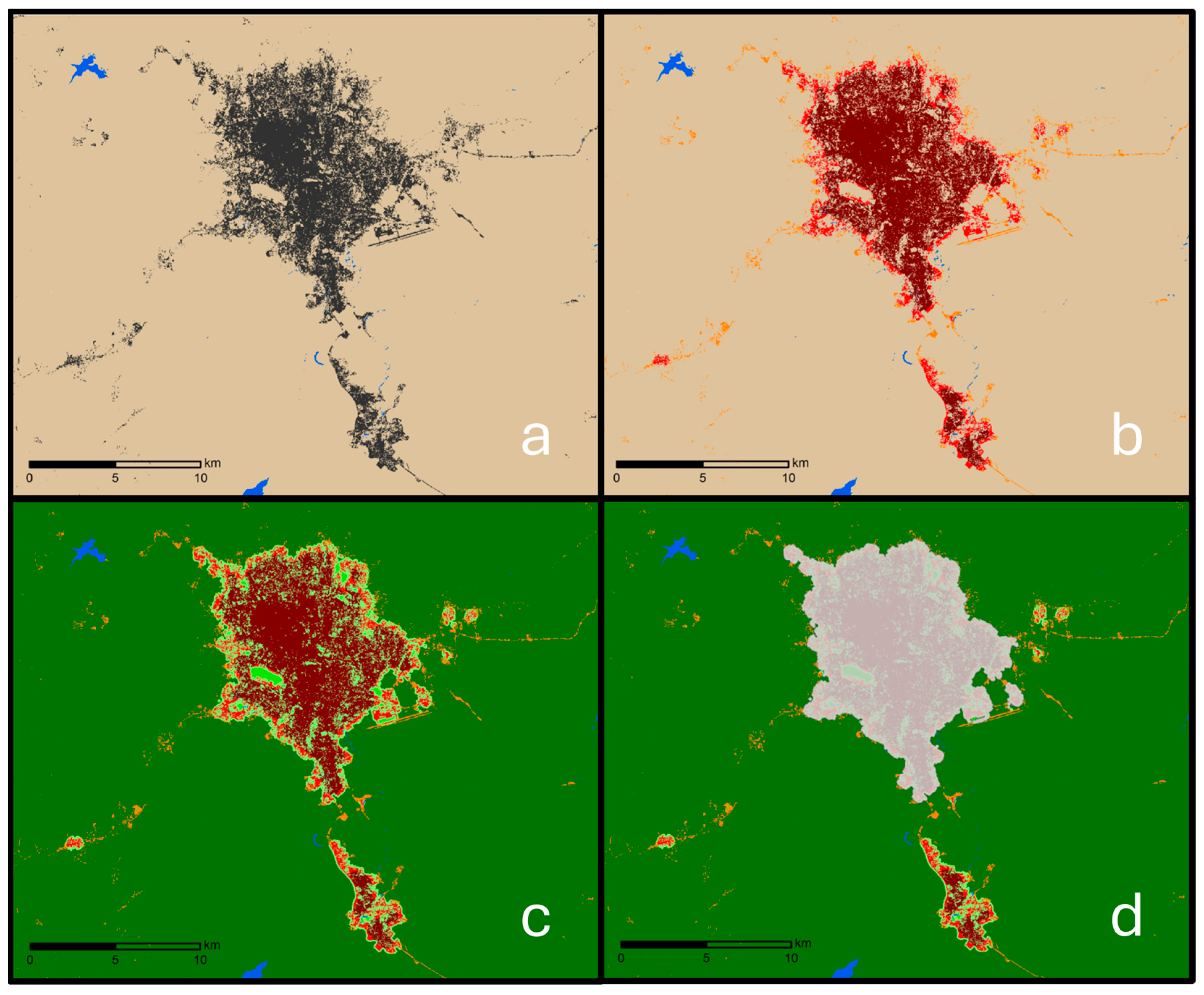
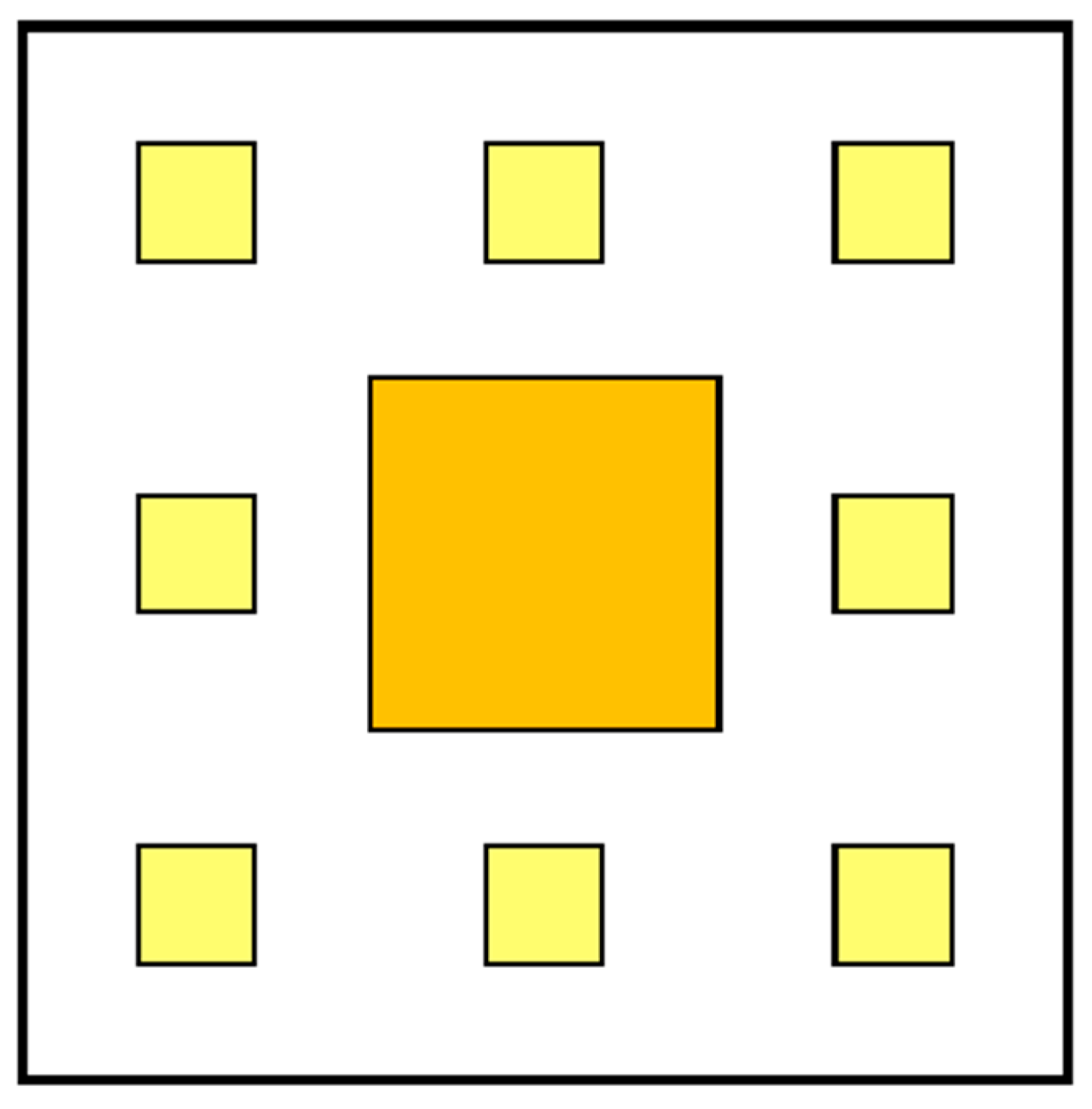
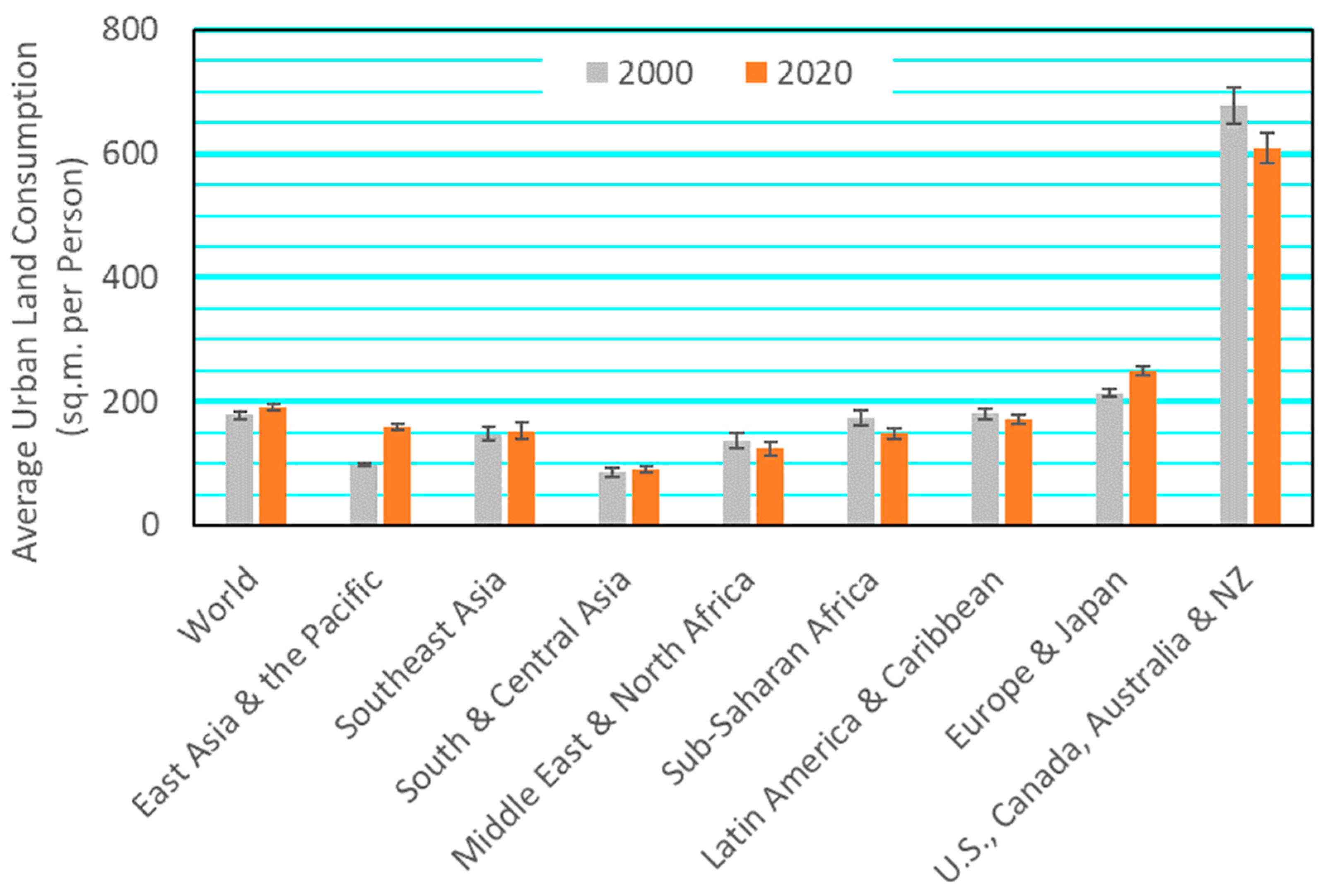
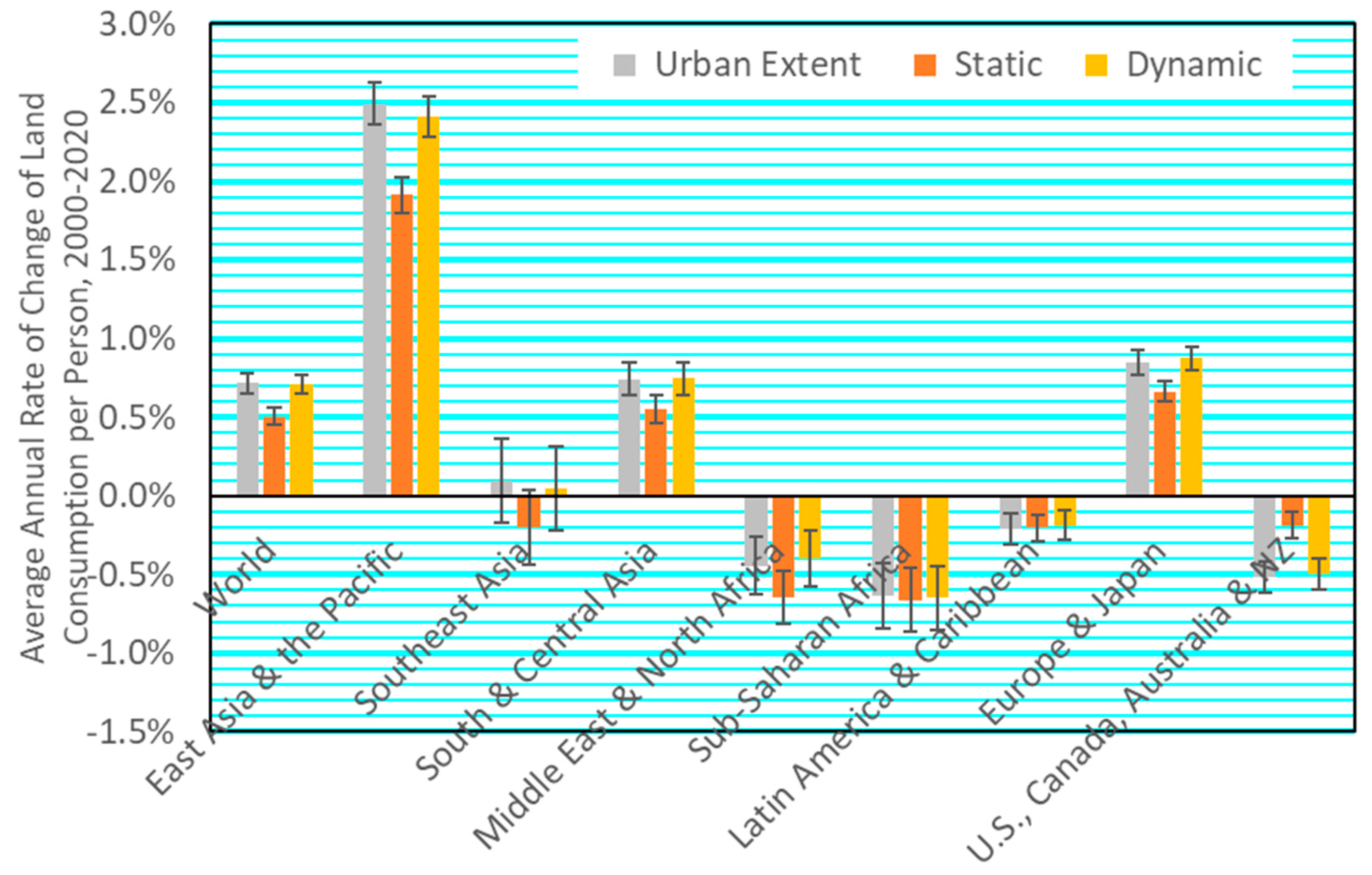
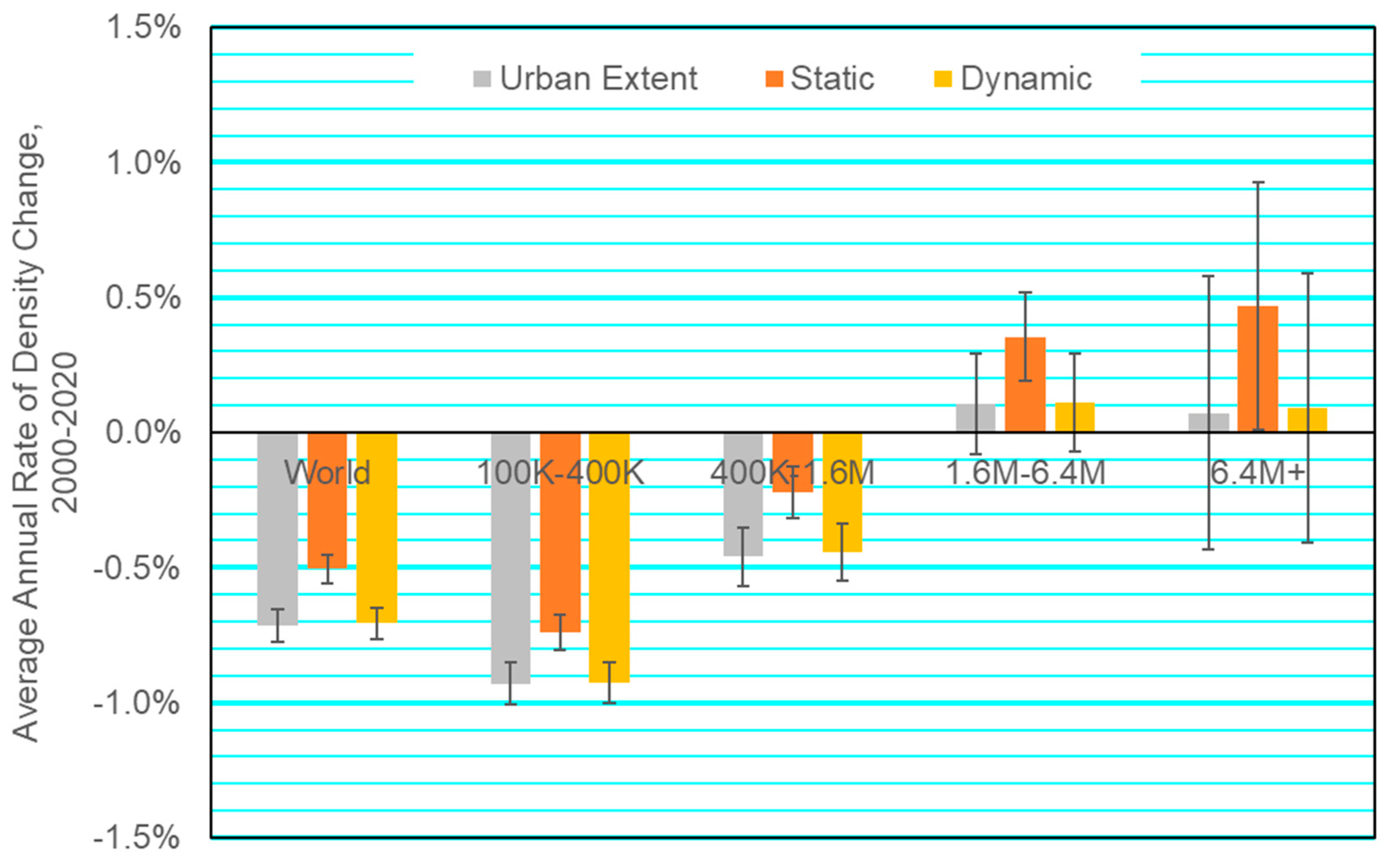
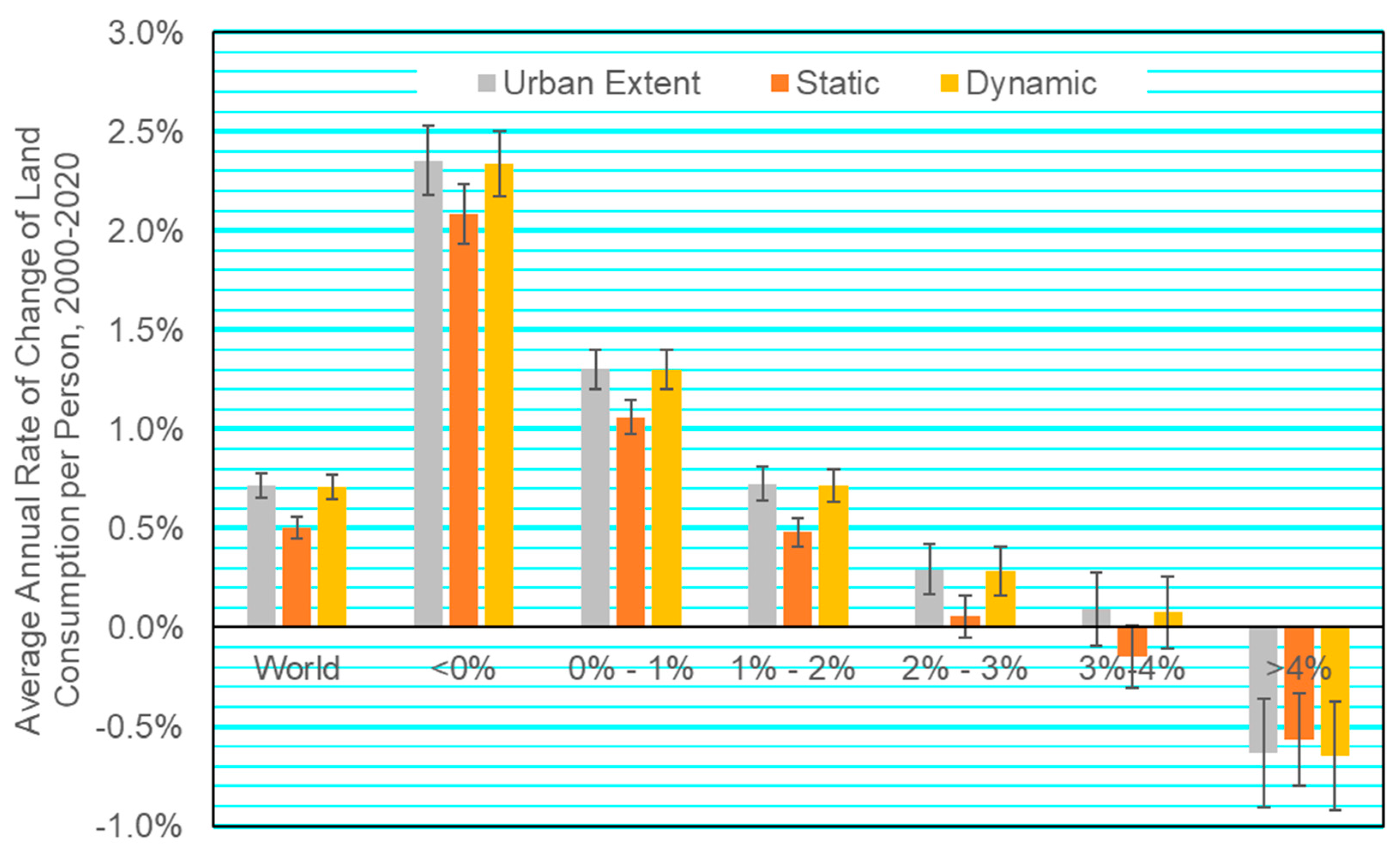
Disclaimer/Publisher’s Note: The statements, opinions and data contained in all publications are solely those of the individual author(s) and contributor(s) and not of MDPI and/or the editor(s). MDPI and/or the editor(s) disclaim responsibility for any injury to people or property resulting from any ideas, methods, instructions or products referred to in the content. |
© 2024 by the authors. Licensee MDPI, Basel, Switzerland. This article is an open access article distributed under the terms and conditions of the Creative Commons Attribution (CC BY) license (https://creativecommons.org/licenses/by/4.0/).
Share and Cite
Angel, S.; Mackres, E.; Guzder-Williams, B. Measuring Change in Urban Land Consumption: A Global Analysis. Land 2024, 13, 1491. https://doi.org/10.3390/land13091491
Angel S, Mackres E, Guzder-Williams B. Measuring Change in Urban Land Consumption: A Global Analysis. Land. 2024; 13(9):1491. https://doi.org/10.3390/land13091491
Chicago/Turabian StyleAngel, Shlomo, Eric Mackres, and Brookie Guzder-Williams. 2024. "Measuring Change in Urban Land Consumption: A Global Analysis" Land 13, no. 9: 1491. https://doi.org/10.3390/land13091491
APA StyleAngel, S., Mackres, E., & Guzder-Williams, B. (2024). Measuring Change in Urban Land Consumption: A Global Analysis. Land, 13(9), 1491. https://doi.org/10.3390/land13091491





